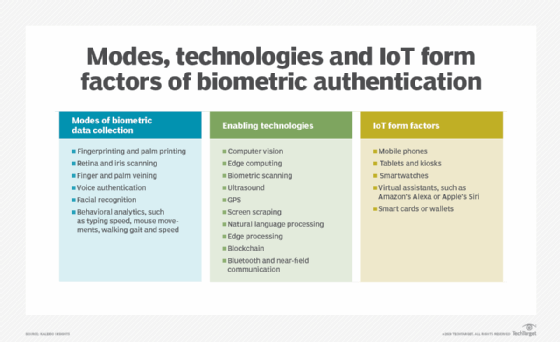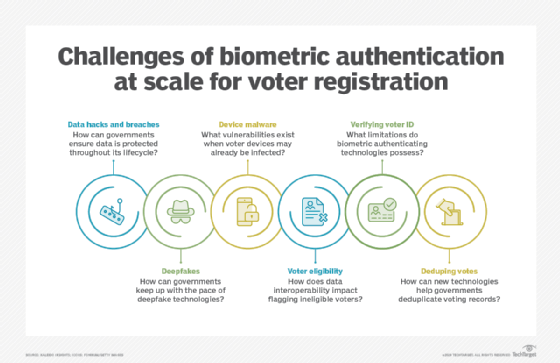
Prostock-studio - stock.adobe.co
3 ways to balance biometric voter registration promise, concerns
Biometric voter registration systems could play a role in the future of election security, if developers and governments can address concerns about security and hacking.
With the 2020 U.S. presidential election quickly approaching, conversations have emerged around voter support, turnout, and even potential suppression and election tampering. Discussions often cite new technologies as the possible fix to issues that plague voters and governments alike. Issues of trust extend throughout the voting system, including methodologies in registration, vote collection, ballot counting and verification.
One such set of technologies, biometric authentication, offers new opportunities to increase convenience and voter efficiencies. Biometric authentication refers to the collection of physical or behavioral data that is unique to an individual to prove their identity and provide access to a product, service, event or action.
In this case, biometric authentication would verify and secure voter registration.
There are myriad modes of biometric data collection that IoT technologies make possible, such as fingerprinting, palm veining and behavioral analytics.
Governments around the world -- including those in Australia, Saudi Arabia, the Philippines and Pakistan -- have all moved forward with digital ID systems and plan to continue to explore biometric authentication's promise for voter registration. Biometric authentication can give greater access to elections for populations to vote more easily and efficiently.

Currently in the U.S., various cities have tested biometrically enabled mobile votes and absentee ballots. Voters simply download an app, use biometrics -- such as fingerprints or facial recognition on their phone -- to verify their identity and submit their vote. Election officials later verify the biometric factors via comparison to paper ballot printouts.
Biometric authentication also discourages fraud because of its accuracy in identifying an individual based on multiple biometric markers. For example, recent research has shown that photoacoustic tomography -- the scanning used in finger and palm veining -- is 99% accurate for biometrically acceptance or rejection of an identity. Proponents of biometric authentication also tout its ability to better thwart election rigging and ballot tampering if it is implemented with secure data protocols in place.
Use of biometrics raises opposition
Still, research and opposition to biometric voter authentication is abundant, particularly on current challenges in vote deduplication, voter data protection and privacy, consumer protection laws, and susceptibility to hacking and breach of sensitive data.

An MIT study uncovered the concerns of biometrically enabled mobile voting technologies in the U.S., including vulnerabilities that hackers can use to alter, stop or expose votes, as well as recover secret ballot information.
Another investigation into biometric authentication in Papua New Guinea found deduplication efforts -- the elimination of duplicate votes from one voter -- to be unsuccessful; inconsistent and incomplete biometric enrollment, often skipping the biometric verification step completely; and minors enrolled in the voter registry to receive a fake digital ID.
Biometric authentication challenges require new security policies
Laws around biometric data collection and governmental or corporate use are highly fragmented or lacking across different countries, states, territories and jurisdictions, which hampers responsible use, security and voter protections.
To address the challenges to mass adoption of biometrically authenticated voter registration, it's important to consider the following:
Data governance, security and privacy. To manage new and growing biometrics data, AI governance is critical to map flows, take inventory, and manage access and compliance. Governments and agencies must provide, update and manage physical and cybersecurity and -safety tools, as well as incorporate security training for employees and third-party ecosystem partners, including any organization that has access to voter biometrics data for any purpose.
Data sharing and interoperability within the larger data ecosystem. Policymakers must provide guidance to ensure alignment and mitigate fragmentation across existing data sets. In the Philippines, the country uses securely collected biometric data from its Department of Foreign Affairs in passport registration to register voters.
Policy guidance, new policy and policy reform. Leaders must collaborate on the development of ethical and accountability principles in the design, deployment and use of biometric authentication.
The Biometrics Institute initially shared this guidance at its 2020 online Congress, "the use of biometrics must be proportionate, with basic human rights, ethics and privacy at heart."
The guidance also requires safeguards that ensure rigorous review, fair operations and operator accountability principles that serve as the initial foundation for biometric authentication adoption as part of a larger digital identity strategy.







